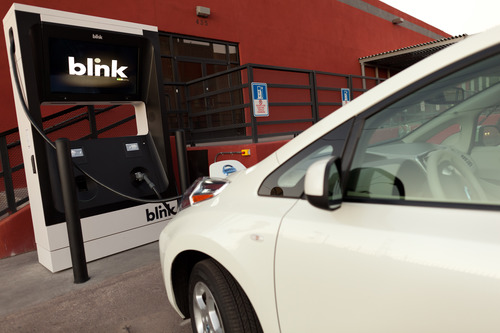Recently I had the occasion to write up a news article about new CHADEMO fast charging stations from Fuji Electric and ABB![]() . In the press release from ABB I noticed a paragraph saying that the station was compatible with the Open Charge Point Protocol. Hmm.. I thought, what does that mean about interfacing such a station with, say, ChargePoint. They operate the largest charging station network in the U.S. and it would be cool if OCPP support meant these statious would be easily attachable to that network. I can say now, after getting a brief phone call with officials at ChargePoint, that indeed OCPP support means a charging station can be easily connected to the ChargePoint but there are some details to know about.
. In the press release from ABB I noticed a paragraph saying that the station was compatible with the Open Charge Point Protocol. Hmm.. I thought, what does that mean about interfacing such a station with, say, ChargePoint. They operate the largest charging station network in the U.S. and it would be cool if OCPP support meant these statious would be easily attachable to that network. I can say now, after getting a brief phone call with officials at ChargePoint, that indeed OCPP support means a charging station can be easily connected to the ChargePoint but there are some details to know about.
First, OCPP is a general protocol for charging station’s to connect together to form a charging station network. The web site is at http://www.ocpp.nl/![]() and while the protocol was invented in the Netherlands, the membership of the OCPP is global.
and while the protocol was invented in the Netherlands, the membership of the OCPP is global.
Second, ChargePoint existed before OCPP came onto the scene. This means that the protocols used inside ChargePoint’s network predate the OCPP. ChargePoint is a member of the OCPP and is working with the OCPP to improve the protocol, and has also made sure the ChargePoint network supports connection by OCPP compatible electric car charging stations.
The ChargePoint officials explained to me that connecting a charging station to ChargePoint is more than just plugging some wires in. The charging station owner has to make a business arrangement first with ChargePoint. At that time they’ve given some information that they then program into the charging stations, so that the charging stations are authenticated with the network. I neglected to ask, but I suspect this is similar to an API token a developer gets when registering to use a web service in an application. The service provider provides the token, and the developer writes their code to supply that token with every API call for authentication.
The conversation did turn to the new effort between ChargePoint and Blink – Collaboratev.
Inside the charging station network there’s a bunch of technical work going on to develop a new protocol that supports connecting charging station networks together.
 The protocols for a charging station network to talk with its charging stations have events centered around charging station control. However, the protocol where two charging station networks talk together has to be different because their conversation is about other things like cross-network user authentication, or payments settlements.
The protocols for a charging station network to talk with its charging stations have events centered around charging station control. However, the protocol where two charging station networks talk together has to be different because their conversation is about other things like cross-network user authentication, or payments settlements.
The purpose of Collaboratev is to act as a clearing house between charging station networks. The public story is that a member of network B can use charging stations owned by network C, and vice-versa. Eventually Collaboratev intends to allow other charging station networks to join up, say network E perhaps? (BTW – “B” is Blink, “C” is ChargePoint, and “E” is eVgo)
Behind the scenes the implementation is an Internet based service which acts as a clearing house of information between electric car charging station networks. We didn’t go into any details on the information exchange, but I imagine it centers on authentication and payments settlements as I said.
The conversation was all-too-brief but I hope this much was useful.
- Highway design could decrease death and injury risk, if “we” chose smarter designs - March 28, 2015
- GM really did trademark “range anxiety”, only later to abandon that mark - March 25, 2015
- US Government releases new regulations on hydraulic fracturing, that some call “toothless” - March 20, 2015
- Tesla Motors magic pill to solve range anxiety doesn’t quite instill range confidence - March 19, 2015
- Update on Galena IL oil train – 21 cars involved, which were the supposedly safer CP1232 design - March 7, 2015
- Another oil bomb train – why are they shipping crude oil by train? – Symptoms of fossil fuel addiction - March 6, 2015
- Chevron relinquishes fracking in Romania, as part of broader pull-out from Eastern European fracking operations - February 22, 2015
- Answer anti- electric car articles with truth and pride – truth outshines all distortions - February 19, 2015
- Apple taking big risk on developing a car? Please, Apple, don’t go there! - February 16, 2015
- Toyota, Nissan, Honda working on Japanese fuel cell infrastructure for Japanese government - February 12, 2015
















